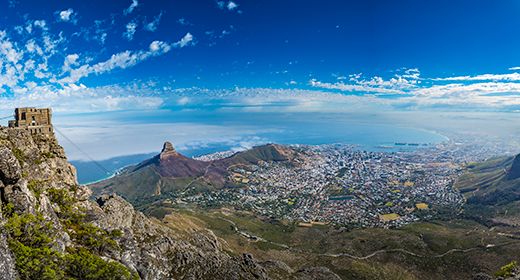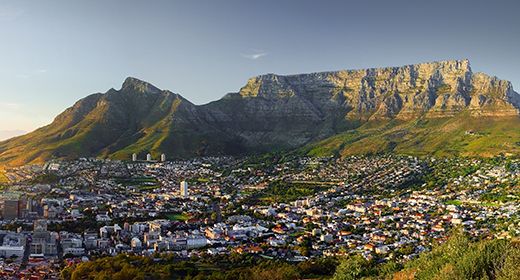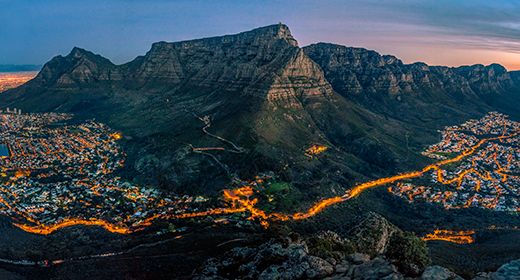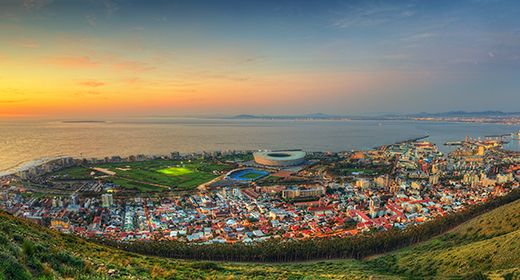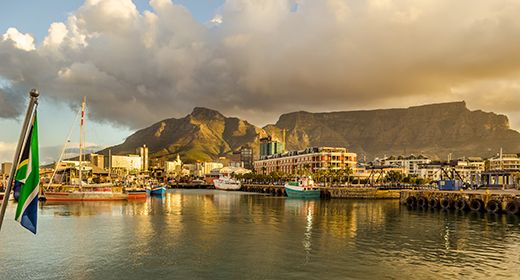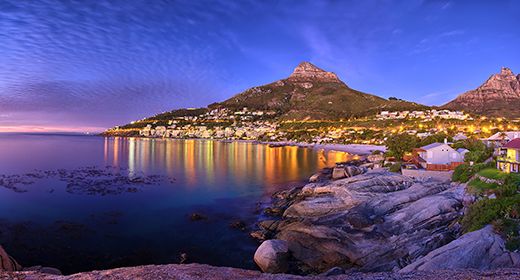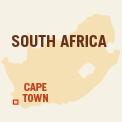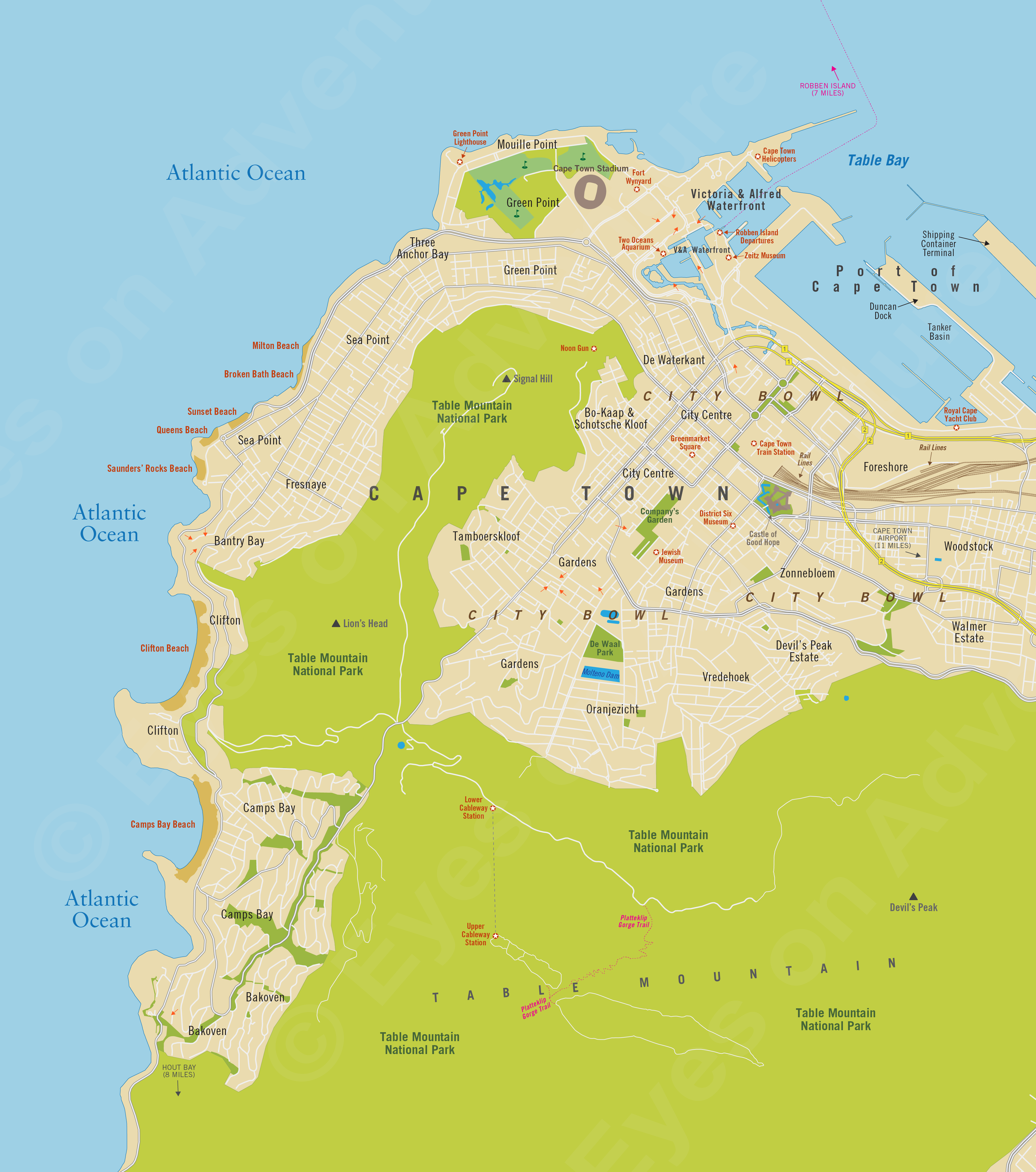Cape Town
(incl. Table Mountain, Camps Bay, Bantry Bay, Victoria & Alfred Waterfront)
Region Links: Cape Peninsula, Cape Town, Cape West Coast, Cape Winelands, Eastern Cape, Garden Route, Gauteng Province, Johannesburg, Kruger Park & Lowveld, Kruger Private Reserves, KwaZulu-Natal, Madikwe, Overberg & Whale Coast, Pilanesberg & Sun City, Sabi Sand Reserve
Highlights
- Visit South Africa's most-visited tourist attraction, the Victoria & Alfred Waterfront
- Take the cablecar or hike to the top of Table Mountain for spectacular views
- Tour Robben Island where Nelson Mandela was imprisoned for 18 years
- Shop, dine and explore the various neighborhoods in the City Bowl
- Spend a day at the Blue Flag Award-winning beaches in Clifton or Camps Bay
EOA Recommends: Cape Grace Hotel, Kensington Place, The Clarendon Bantry Bay, Welgelegen Boutique Hotel
Cape Town, the "Mother City", is undoubtedly the most unique and scenic urban destination on the Africa continent. Unlike most African cities, Cape Town is a true tourist destination and a week spent in Cape Town is barely enough.
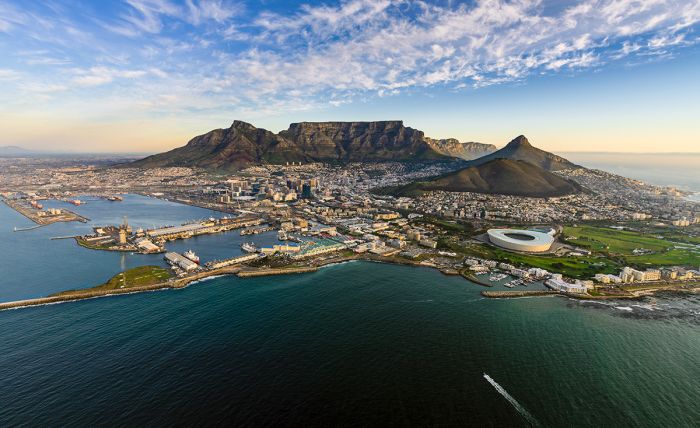
Aerial view over Cape Town and Table Mountain, South Africa
The spectacular Table Mountain towers over the city and distinguishes the entire Cape Peninsula. Its flattened top, often cloaked in clouds referred to as "the table cloth", is an integral part of the city and suburbs below. The views from the top are breathtaking and hiking or taking the cablecar to the top is a must!
The natural beauty of Cape Town is undeniable, with beaches backed by mountains, botanical gardens, and historical buildings dating to the 1600s. The sense of history also defines the Cape, as it was here that South Africa as it is today, has its roots.
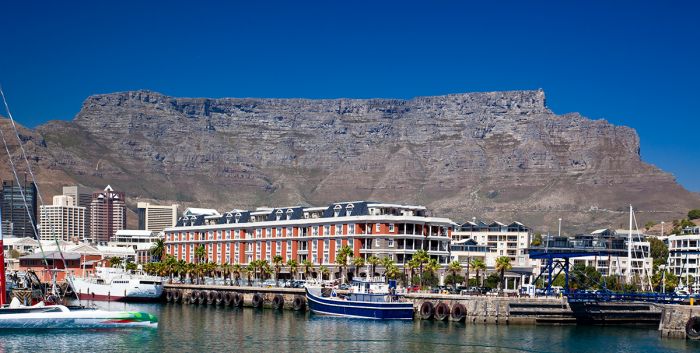
View from the Victoria & Alfred Waterfront in Cape Town
Cape Town is a place for outdoor adventure and sightseeing. Visit the Constantia Winelands, hike the trails in Table Mountain National Park, go on a shark-viewing excursion in False Bay, walk the neighborhoods of Gardens and Orangezicht for the variety of shops and markets, walk the splendid Kirstenbosch Botanic Gardens, drive to the southern tip of the peninsula for Cape Point and the Cape of Good Hope, and take a walking tour of Robben Island where Nelson Mandela was once imprisoned. All of this can be done while based in Cape Town.
Accommodations are plentiful and diverse enough to satisfy any desire... from quaint guest houses in the suburbs beneath Table Mountain, to luxury hotels on the Victoria & Alfred Waterfront, to villas overlooking the Atlantic Ocean. Whatever you do, add a visit to Cape Town to your itinerary or you'll miss out on all this vibrant city has to offer.
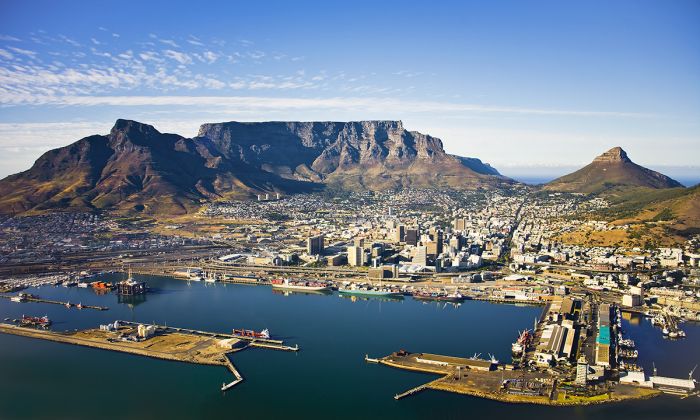
View of Cape Town's City Bowl with the Port of Cape Town harbor
More ...
Bakoven, Bantry Bay, Bo-Kaap, Camps Bay, Castle of Good Hope, Central Business District (CBD), City Bowl, City Centre, Clifton, Company's Garden, De Waterkant, District Six, Gardens, Green Point, Greenmarket Square, History, Lion's Head, Mouille Point, Oranjezicht, Robben Island, Sea Point, Signal Hill, Table Mountain, Tamboerskloof, Victoria & Alfred Waterfront, Woodstock
History
Stone-age tools dating back 1.5 million years old have been discovered on the Cape Peninsula, placing humans here at least that long ago. The San, a hunter-gatherer people, arrived some 30 000 years ago and later the Khoikhoi people, a pastoralist tribe, who arrived in the region 2 000 years ago.
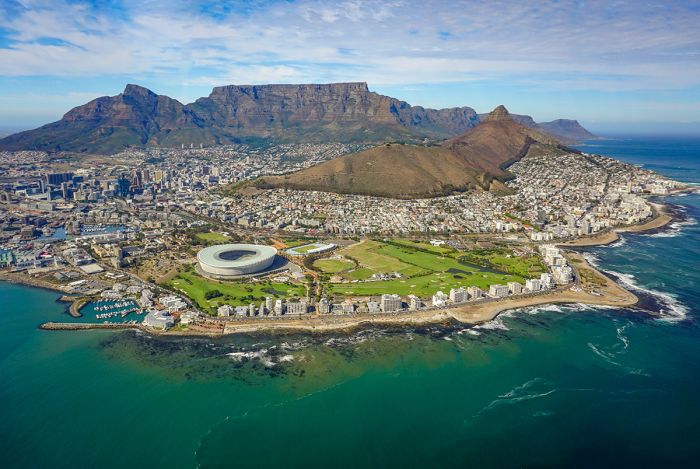
View over Cape Town and Table Mountain
In 1488, Bartolomeu Dias led a Portuguese expedition down the coast of Africa and encountered heavy storms at the Cape's southern tip, which he dubbed Cabo das Tormentas, the 'Cape of Storms'. Portugal's King John officially renamed the point the Cape of Good Hope, as he saw it as the key to a successful trade route with India.
In 1652, the Dutch established an official station at Table Bay to serve as a refreshment port for its ships traveling between Europe and the Far East. Within 100 years, Kaapstad (Cape Town) had over 1 000 buildings and was a bustling town, home to Europeans and slaves, both African and those imported from Java, Guinea, and Madagascar, which actually outnumbered the free settlers.
The British captured Cape Town from the Dutch in 1795, and in the Anglo-Dutch Treaty of 1814, Cape Town was permanently ceded to Britain. It became the capital of the new Cape Colony and its territory expanded greatly throughout the 1800s. Conflicts with the Boer Republics, which wanted to secede from the British rule, resulted in the Boer Wars, the second of which spanned 1899-1902, which Britain won.
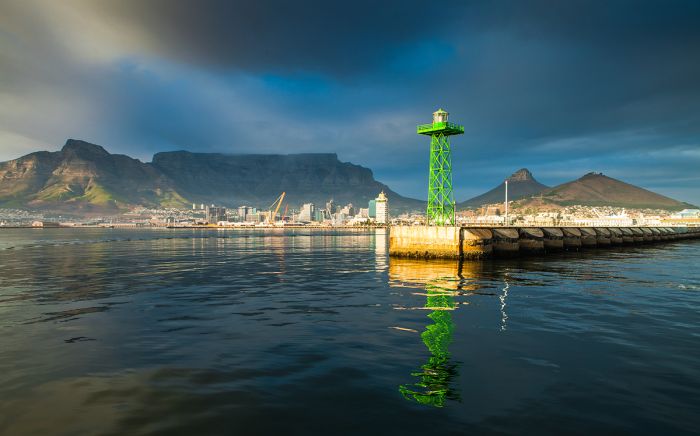
Lighthouse beacon at the entrance to Cape Town's harbor
In 1910, the British established the Union of South Africa, which officially united the Cape Colony with the two defeated Boer Republics, as well as the British colony of Natal. Cape Town became the legislative capital of the Union and later of the Republic of South Africa.
Today Cape Town and the Western Cape are populated by a racially diverse mix of people, including a large percentage of so-called Coloureds, which are racially mixed descendants of the early white settlers and their slaves. Roughly 75% of the Western Cape's population speaks English or Afrikaans (a Dutch derivative) as their first language.
The Western Cape has long been ruled by the Democratic Alliance (DA) party, the chief political opposition to the country's ruling African National Congress (ANC) and the sole chink in the ANC's national political dominance. The DA has its roots in the founding of the anti-apartheid Progressive Party in 1959. The party is predominantly supported by Afrikaans and English-speaking citizens.
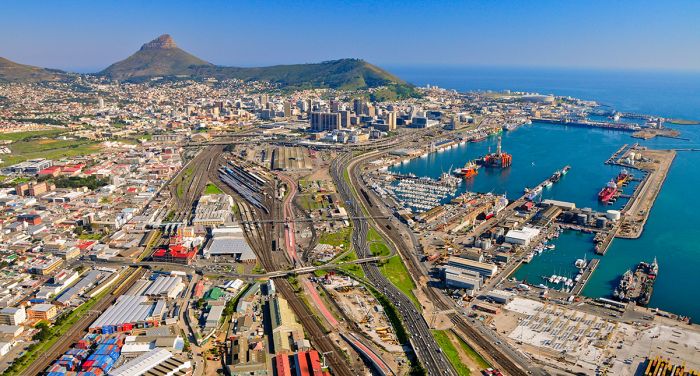
View over Foreshore showing the rail lines, Port of Cape Town, Lion's Head, Signal Hill
City Bowl
The amphitheater-shaped basin lying below the slopes of Table Mountain, Lion's Head and Signal Hill is an area known as the City Bowl. It includes numerous neighborhoods, which have softly-defined borders between them.
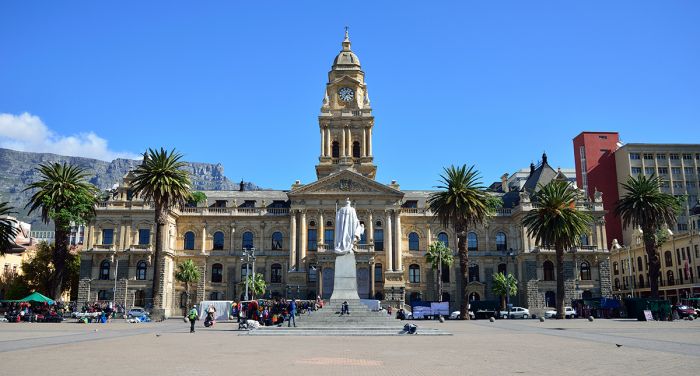
Cape Town's City Hall
THE CITY CENTRE
The City Centre is also known as the Central Business District (CBD). Modern steel office buildings mix with historic landmark buildings dating back to the 1600s and street vendors selling everything imaginable to create this vibrant locale in the middle of the City Bowl. Driving here is hectic and walking is a much better way to explore the art galleries, markets, cafés, bars and coffee shops. The area is undergoing ongoing rejuvenation, with the older city buildings being converted into modern apartments.
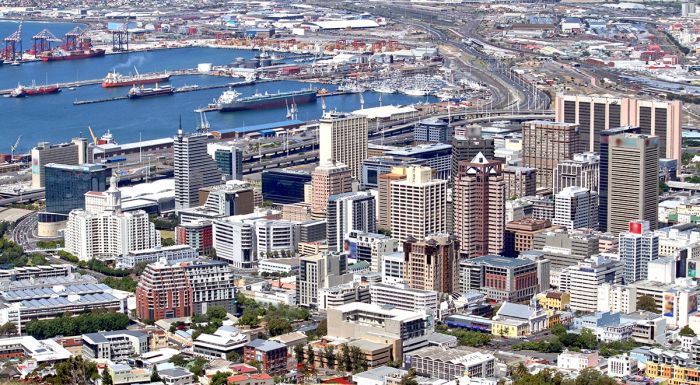
North end of the City Centre or Central Business District (CBD) of Cape Town
The Company's Garden forms the largest green space in the city centre and is a lovely oasis in the middle of the busy city streets. Originally established by Jan van Riebeek just weeks after he arrived in 1652, it is all that remains of a 43-acre vegetable garden used to supply fresh produce to Dutch ships en route to and from India. Today it's a popular lunch spot for local city workers and the self-guided walking trail includes historic statues, old trees and the famous Gardens Tea Room. Some of the city's museums border the garden.
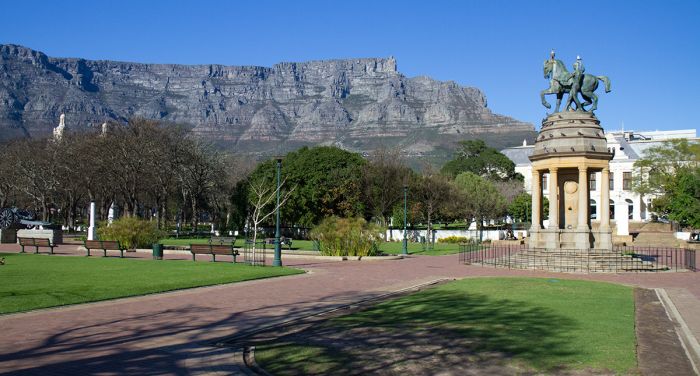
The Company's Garden in Cape Town
The District Six Museum is housed in an old church and commemorates the municipal suburb established in 1867 that was home to a vibrant multicultural community of freed slaves, immigrants and Coloureds. When the apartheid government declared District Six a 'Whites-only' area in 1966, all 60 000 of its residents were evicted and forced to relocate to the desolate outlying Cape Flats area. In the 1970s, all buildings except for churches and mosques were razed to make way for the planned redevelopment. The museum is one of the best in Cape Town. A two-hour guided tour can be booked in advance or you can walk through on your own.
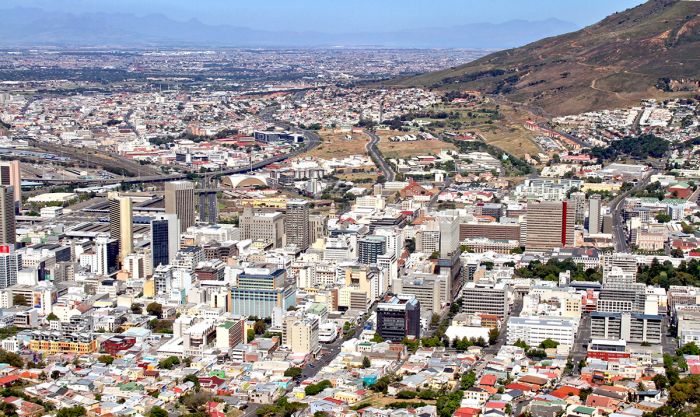
Cape Town City Centre, with the empty area of old District Six clearly visible
The cobbled Greenmarket Square is located in the middle of old Cape Town and has existed since 1696, when it was known as Burgher Watch Square. It served as the local slave market from 1710 until the abolition of slavery in 1834. Since the end of apartheid in the 1990s, the square has seen a revitalization and today it is an energetic market, with pan-African vendors selling all manner of curios and clothing from across the continent. The market attracts an animated ensemble of musicians, mimes and other street performers. The square is surrounded by numerous examples of art-deco architecture, as well as historic buildings like the Old Townhouse, built in 1755.
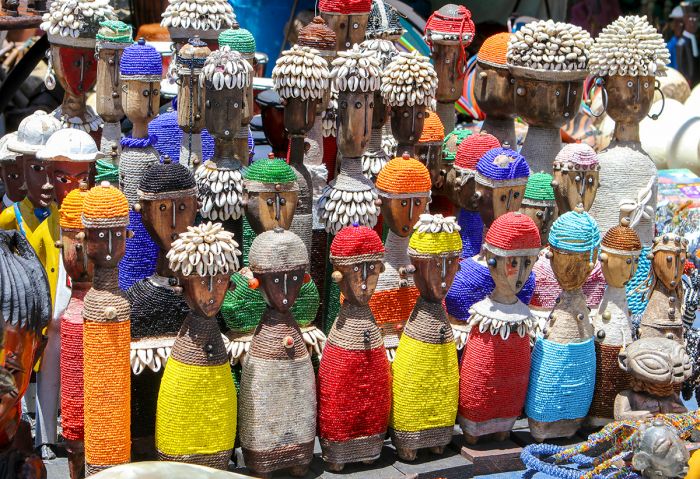
African crafts sold at Greenmarket Square in Cape Town
The pentagonal shaped Castle of Good Hope was constructed by the Dutch between 1665 and 1676 to replace the earthen one built by Jan van Riebeek in 1652. It is the oldest building in the country and in those days, the naval fortification was surrounded by a moat and situated at the edge of the harbor. The Dutch practice of dumping rubble into the ocean in order to reclaim land from the sea, extended the city several square miles and today, the fort is more than a half mile from the ocean. You can explore the castle on your own or join an informative guided tour.
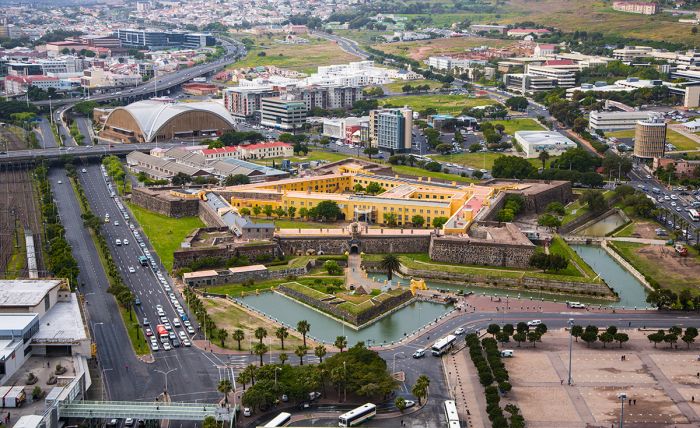
Aerial view of the Castle of Good Hope in Cape Town
Victoria & Alfred (V&A) Waterfront
The V&A Waterfront is South Africa's most-visited tourist attraction and is hugely popular with tourists and locals alike. Originally developed at the turn of the 20th century to accommodate shipping requirements, it is named for Queen Victoria and her son, Alfred. By the 1990s, the harbor had become very rundown and a long-term redevelopment project was initiated to reinvigorate the old docks into a major tourist attraction.
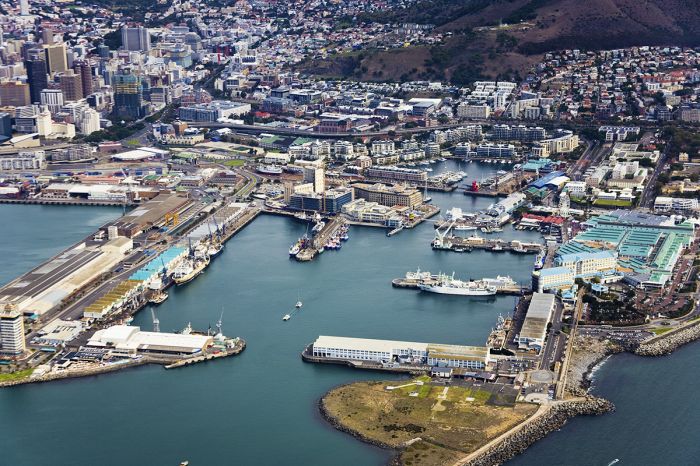
Aerial view over the Victoria & Alfred Waterfront in Cape Town
Today there are hundreds of shops, restaurants, craft and food markets, bars, movie theaters, hotels, and other leisure activities. Some of the shops and activities are in housed a massive new indoor mall and some are located in restored warehouses and dock buildings. A key attraction for tourists is that it is safe, clean, enormous, and allows for moving about on foot between all the venues.
The Two Oceans Aquarium is one of the world's best and maintains sea life from both the warm Indian Ocean and the frigid Atlantic Ocean. The aquarium is great for kids, with hands-on exhibits including a touch-pool.
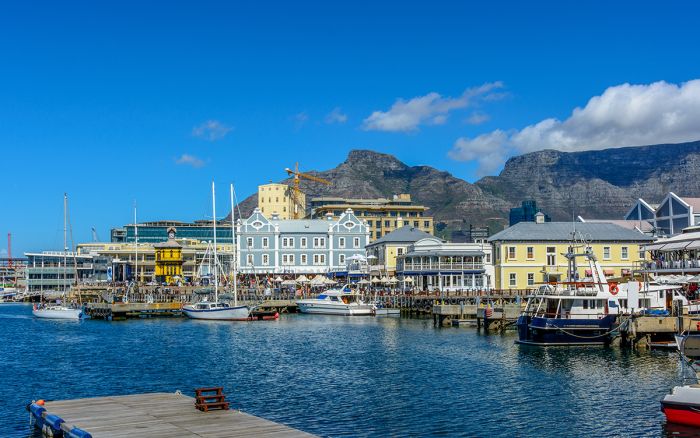
South Africa's top tourist attraction, The V&A Waterfront in Cape Town
Opened in 2017, the Zeitz Museum of Contemporary Art Africa is the continent's first major modern art museum. It occupies a renovated grain silo in what is now called the Silo District area of the V&A Waterfront.
South Africa's version of Alcatraz Island is Robben Island, the historic prison-island which was home to Nelson Mandela for 18 years of his imprisonment. Today the island is a museum and 4-hour tours of the island leave from the V&A Waterfront leave 3 or 4 times daily, depending on the season and weather. The boat ride to the island takes 45 minutes and the tours are informative and sobering. Booking 3 weeks in advance is recommended. Weather can cause cancellations.
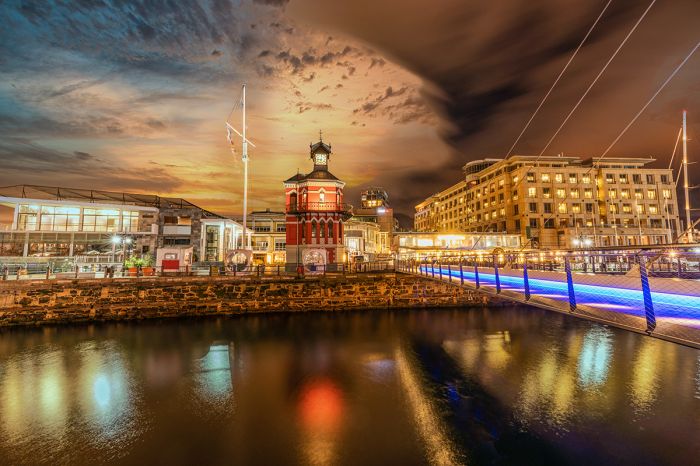
The V&A Waterfront and the famous clock tower
Table Mountain
The spectacular, flat-topped massif that presides over Cape Town is called Table Mountain. It is without doubt one of Africa's most iconic natural features and the views from its summit are breathtaking. A trip to the top, either by hiking or via the modern cableway is a must for all first-time visitors the the city. The mountain reaches 3 500 feet (1 070 meters) above Cape Town and can be seen from over 40 miles (65 kms) out at sea.
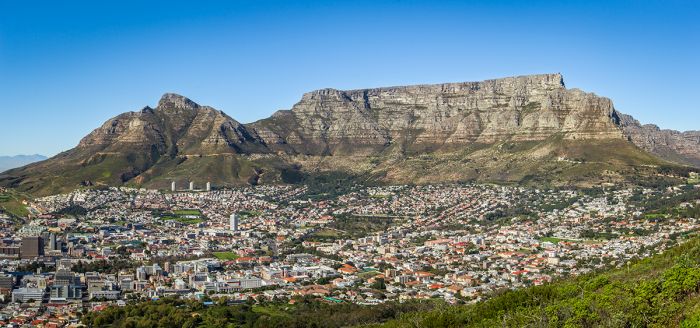
Table Mountain towers above Cape Town, South Africa
Climbing up the popular Platteklip Gorge Trail takes between two and three hours. Bring plenty of water and stay on the marked trail. Climbing in a group or with a guide is recommended.
The most popular way to reach the top is to ride the Table Mountain Aerial Cableway, which consists of two, wheel-chair-friendly, revolving cable cars. The cableway takes around 5 minutes to reach the top. Hours of operation vary seasonally and according to weather. Peak season runs from December thru March, so book online and arrive early or you could wait in line for an hour or more. Also note that the cableway does not operate when there are strong winds, a common occurrence during the peak summer months.
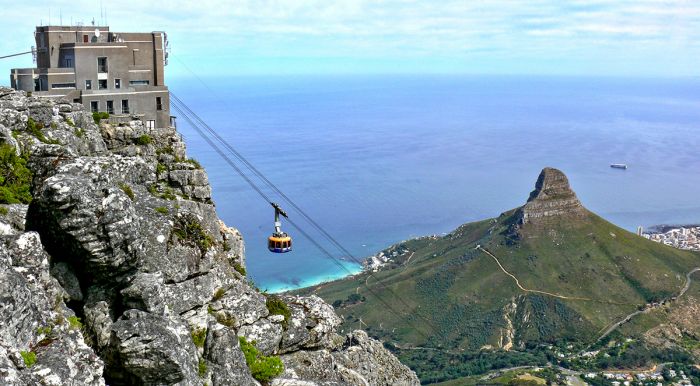
The Table Mountain Cableway takes visitors to the mountain top
LION'S HEAD AND SIGNAL HILL
To the west of Table Mountain are two other significant peaks that rise up above the city. Lion's Head is a popular hiking spot for Capetonians. The climb to the top is not rigorous and takes about 90 minutes each way. The views along the trail and from the summit are spectacular. The trail can become clogged on nice days, but as with Table Mountain, never hike alone.
Signal Hill is the easiest to climb and is more of a flat-topped hill than a mountainous peak. There is also a road and parking area, so driving up is also possible. Sunset drinks from the top are a popular activity for locals and tourists, but plan to arrive early and expect a crowd. The drive back down is always a standstill.
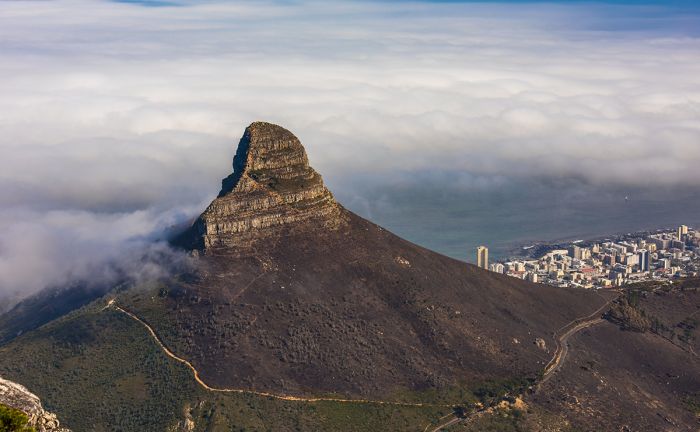
Lion's Head peak viewed from Table Mountain
Signal Hill gets its name from the early settler days when signal flags were used to communicate weather conditions to ships arriving in Table Bay. Signal Hill is also home to one of Cape Town's oldest living traditions, the Noon Gun. In operation since 1806, the gun fires at noon sharp (except Sundays and public holidays) and was originally used to allow ships in port to check the accuracy of their marine chronometers. Ships further out at sea would use the puff of smoke from the gun rather than the boom of the canon, as it takes time for the sound to reach them from a distance.
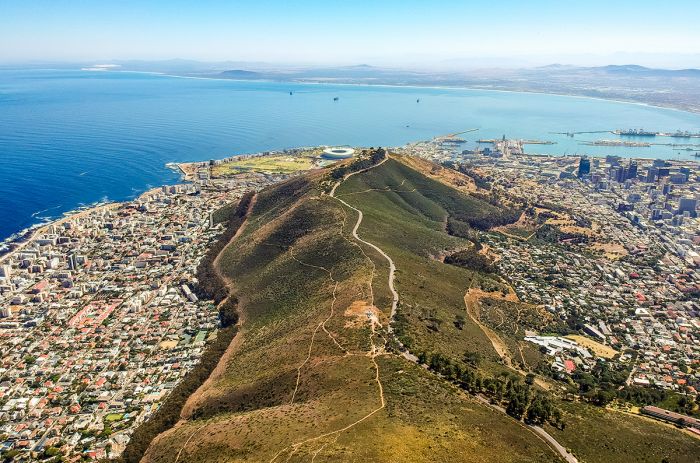
Signal Hill viewed from Lion's Head
Bo-Kaap
Located on the lower slopes of Signal Hill, Bo-Kaap (meaning upper Cape) is the historic home to Cape Town's Cape Malay and Muslim communities, which were originally brought here as slaves in the late 1600s and early 1700s. Formerly known as the Malay Quarter, the neighborhood's colorfully painted row houses, many dating back to the 1700s, are a unique attraction. There are several historic mosques that are dotted along the cobbled lanes, as well as the Bo-Kaap Museum, which is housed in an 18th-century home. A guided tour of the neighborhood and museum is recommended.
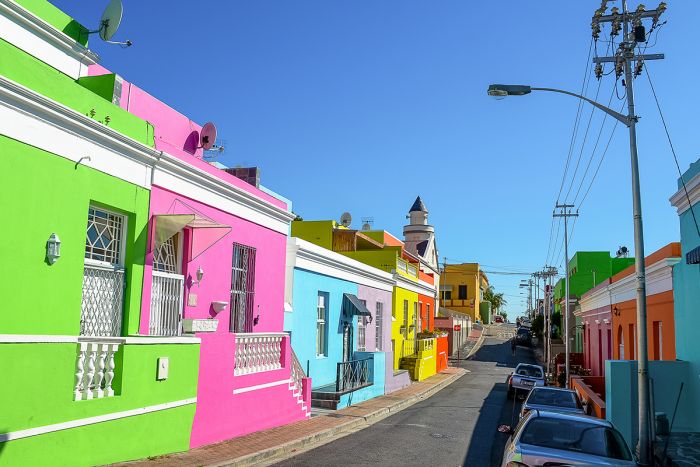
Colorful houses in the Bo-Kaap neighborhood of Cape Town
GARDENS
Located south of the Company's Garden, the affluent Gardens neighborhood offers a mix of residential and commercial, with upscale homes, restaurants, hotels, guest houses, cafés, and shops. The popular Kloof Street runs through the neighborhood and is lined with eclectic boutiques and eateries. It is a very popular place for tourists to base themselves and explore day and night, with its commercial zone remaining lively past sunset. Cape Town's Labia Theatre, an art-house cinema opened in 1949, screens cult, classic and art movies.
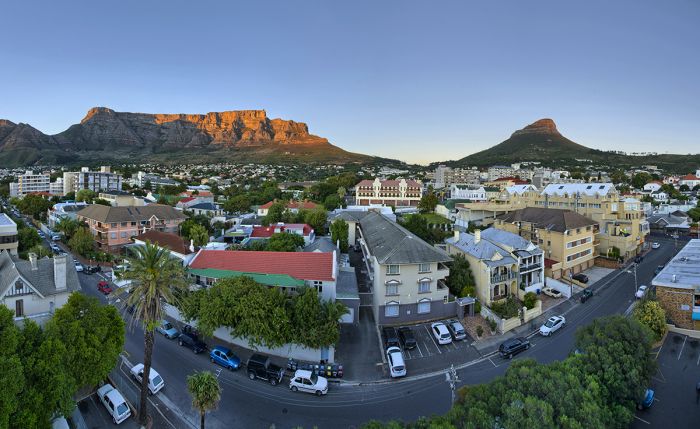
The Gardens neighborhood of Cape Town, showing Lion's Head and Table Mountain
Oranjezicht and Tamboerskloof
These two lovely and affluent neighborhoods border Gardens on either side and offer coffee shops, boutiques, restaurants, cafés, and some guests houses.
Woodstock
Once a fashionable seaside resort in the mid-1800s, with a beach that extended all the way to the Castle of Good Hope, Woodstock now sits a good distance from the sea due to continued land reclamation over many decades around Table Bay. During the late 1800s, Woodstock became home to a fast-growing working-class population, most of which worked at the harbor docks.
In the 1930s and 1940s, more concerted land reclamation was undertaken, creating the suburb of Foreshore and the Woodstock beach was lost. Woodstock increasingly became an industrialized suburb through the remaining decades of the 20th century. Today however, there is a push towards urban renewal and is home to restored Victorian homes, galleries, shops, restaurants (including the top-rated Test Kitchen), the trendy Old Biscuit Mill Saturday market.
Green Point & De Waterkant
Green Point is an affluent suburb on Cape Town's Atlantic Seaboard and a popular residential area for working professionals. It is the unofficial home of Cape Town's LGBTQ community.
Cape Town Stadium was built on the Green Point Common for the 2010 FIFA World Cup and an urban park was subsequently added around the stadium. Also on the Common is the 18-hole Metropolitan Golf Club, first established in 1895 and rebuilt in 2010.
De Waterkant is a sub-district of Green Point which borders the City Centre and Bo-Kaap. It is a highly sought-after neighborhood, especially amongst the affluent gay and lesbian community. There are also some retailers and restaurants.
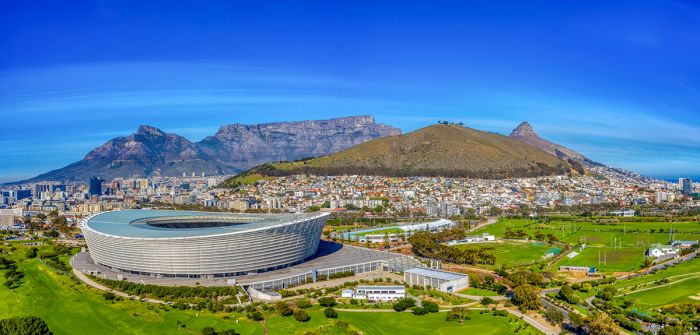
Cape Town Stadium on Green Point Common, Cape Town
Mouille Point
This affluent suburb hugs the coastline north of Green Point Common and is defined by having only two major roads (Beach Road and Bay Road) and its high-end apartment blocks. The popular Mouille Point Promenade is a paved walkway along the coast that is used daily by thousands of Capetonians for walking and jogging.
First lit in 1824, the Green Point Lighthouse was the first solid lighthouse structure on the South African coast and is the oldest operational lighthouse in the country.
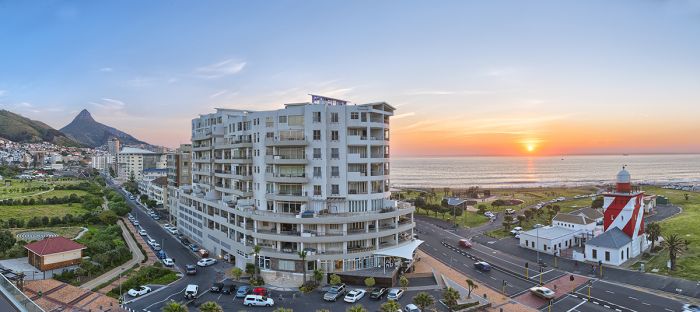
Sunset at Mouille Point with the Green Point Lighthouse
Sea Point
One of Cape Town's most affluent and densely populated residential suburbs, Sea Point lies along the coast between Signal Hill and the Atlantic Ocean. It is known for its seaside high-rise developments and the popular coastal promenade that starts in Green Point and is well used by locals for jogging, walking and socializing.
Bantry Bay & Clifton
Bantry Bay is home to numerous boutique hotels and guest houses overlooking the ocean from the slopes of Lion's Head, this is one of Cape Town's most prestigious suburbs. The small and exclusive enclave offers dramatic sea views and although it has no beach of its own, provides easy access to nearby beaches.
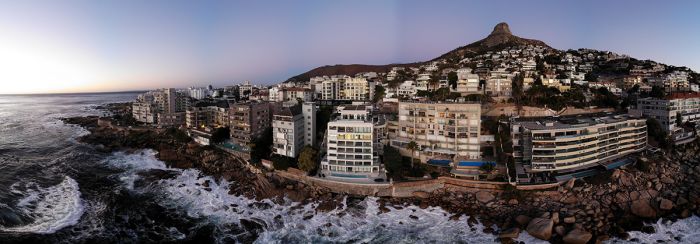
Exclusive seaside apartments in Clifton, a suburb of Cape Town
Clifton is an exclusive residential suburb boasting the most expensive real estate in South Africa, with many house perched atop cliffs with sweeping vistas over the Atlantic Ocean. Clifton has are four separate beaches (named 1st to 4th) that are separated by large boulders and together make up the greater Clifton Beach. The water is cold but the sand is soft and there is seldom any wind. Clifton's 4th beach has been awarded the prestigious Blue Flag Award.
Bantry Bay and Clifton sit in the wind shadow of Lion's Head, which shelters them and the very popular Clifton Beach from the notorious southeast winds prevalent during summer (October-April). This is known to be the most wind-sheltered spot along the coast, with almost 300 wind-free days per year in a city known for its big winds.
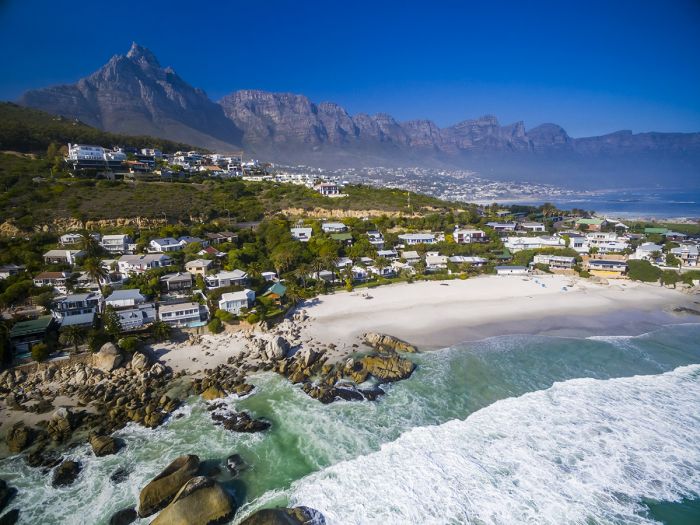
The award-winning Clifton Beach
Camps Bay
Home to the the beautiful and wide Camps Bay Beach and a long strip of trendy beachfront restaurants, cafés, and cocktail bars overlooking the seaside promenade, Camps Bay is a very popular locale for Capetonians and tourists alike. The white sand beach is one of the best on the peninsula and has received the Blue Flag Award. It draws big crowds on nice days, especially on weekends.
The Promenade Mall offers boutique shops selling high-end fashion and beachwear. The Theatre on the Bay is a modern venue that stages plays, comedy and cabarets, plus bistro-style dining.
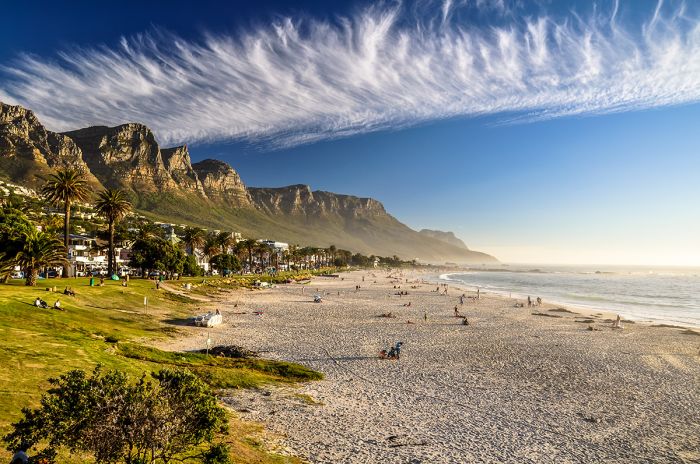
Camps Bay Beach in late afternoon
Bakoven
The last Cape Town suburb south along the Atlantic Seaboard is Bakoven. The ensuing drive down the coast to Llandudno and Hout Bay is one of the most beautiful stretches in the country, with the Atlantic Ocean on one side and the spectacular Twelve Apostles Mountains on the other. Bakoven is a charming and very exclusive community but much quieter and less trendy than Camps Bay, which adjoins it to the north.
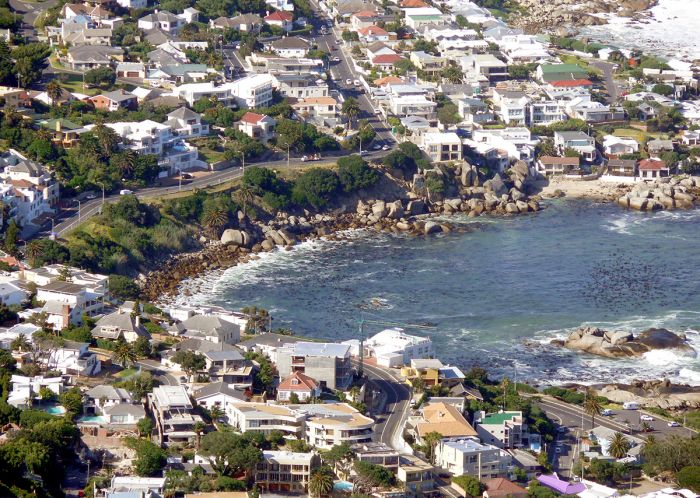
Coastal road through Bakoven
More ...
Bakoven, Bantry Bay, Bo-Kaap, Camps Bay, Castle of Good Hope, Central Business District (CBD), City Bowl, City Centre, Clifton, Company's Garden, De Waterkant, District Six, Gardens, Green Point, Greenmarket Square, History, Lion's Head, Mouille Point, Oranjezicht, Robben Island, Sea Point, Signal Hill, Table Mountain, Tamboerskloof, Victoria & Alfred Waterfront, Woodstock
Great Good Fair Poor
- Jan
- Feb
- Mar
- Apr
- May
- Jun
- Jul
- Aug
- Sep
- Oct
- Nov
- Dec
NOVEMBER THRU FEBRUARY (SUMMER)
Cape Town and the coastal regions of the Western Cape experience warm and dry weather in summer (the rest of the country receives the majority of its rain in the summer). The Mediterranean climate that is prevalent in Cape Town means it gets the majority of its rain in winter. The only downside of the summer months in Cape Town is the wind... Cape Town is known for its windy days, especially in summer. Due to the mostly beautiful and dry weather in summer, this is the peak season for Cape Town.
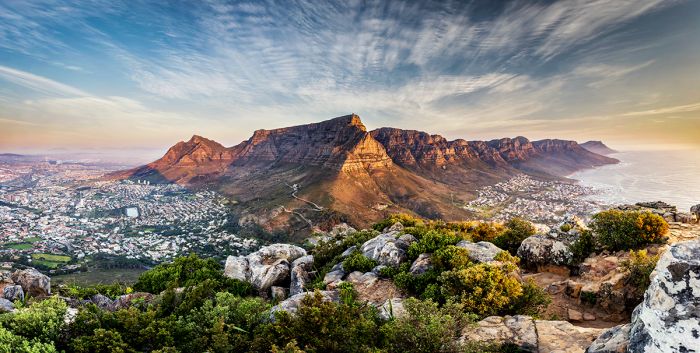
Cape Town and Table Mountain
Summer is beach time in Cape Town and it is also the season for outdoor events. The long, sunny days (the sun sets after 8pm) mean summer is the best time to visit the Cape, which is most an outdoor destination. The food and wine festivals are in full swing, the beaches are fabulous (providing it isn't too windy), and walking, hiking, cycling and boating are all great options. Summer rain are uncommon and the temperatures range between 63-82°F (17-28°C), but can reach as high as 104°F (40°C). Besides for some windy days when the southeasters are blowing, Cape Town's summer weather is beautiful and perfect for Cape Town's huge variety of outdoor activities.
The beautiful weather means flights and accommodation prices are a bit higher and attractions in the Cape are busier, so its advisable to book early if you plan to visit over the summer.
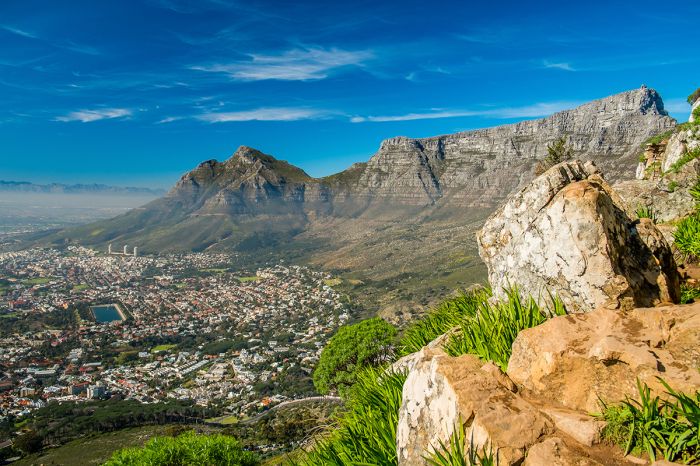
View from Lion's Head showing Cape Town, Table Mountain, and Devil's Peak
MARCH AND APRIL (EARLY-MID FALL)
March and April weather is mostly lovely, with a slightly higher chance for a rainy day. Some of the big festivals are held, including the Cape Town Cycle Tour and the Two Oceans Marathon. Easter holiday should be avoided due to a big increase in local crowds. During the event and holiday weekends, the demand for flights and accommodation means prices can be steep and availability very limited; plan around these times if you can.
The temperatures are pleasant in early fall, ranging between 59-81°F (15-27°C), but the first cold fronts usually move in sometime in April. March usually has 2 or 3 rain days and April around 6 or 7 days of rain. The peak season crowds are gone as summer ends, but holidays and big event weekends are the exception.
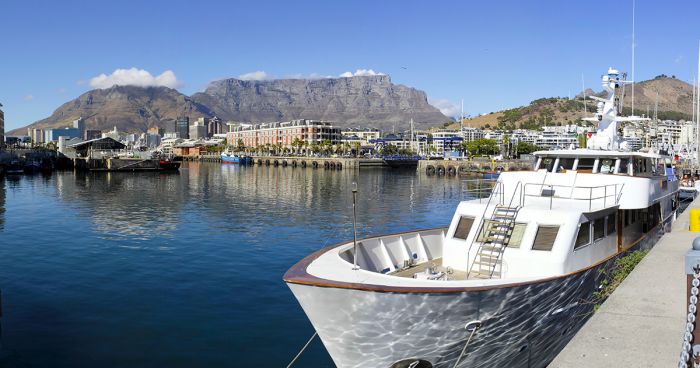
View of Table Mountain from the Victoria & Alfred Waterfront harbor
MAY (LATE FALL)
Late fall in Cape Town means dropping temperatures and the arrival of the first serious rains. The day are typically chilly enough for a sweater, with temperatures ranging between 55-72°F (13-22°C). The less attractive weather means accommodations are generally easy to find throughout the city and surrounding suburbs and attractions have plenty of availability, but the risk of a rainy day means outdoor plans might be spoiled. One advantage is that the winds that are so prevalent during the summer are mostly gone by now, so on the clear days, the beaches and other outdoor adventures are just about the best they can be.
During May there are usually 9 or 10 days of rain. Fall and winter discounted prices are in effect at restaurants and accommodations.
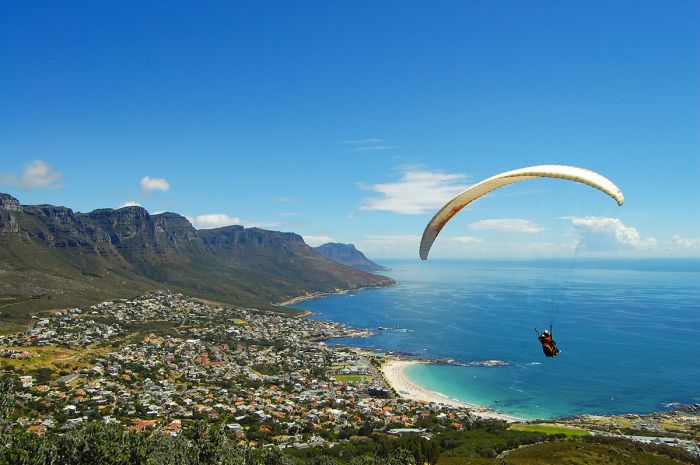
Paragliding from Lion's Head with Camps Bay below
JUNE THRU AUGUST (WINTER)
June thru August is winter and the weather is very chilly and frequently rainy, which means crowds are nonexistent. Bargain winter pricing is in effect for flights, hotels and restaurants. The temperatures range between 52-68°F (11-20°C) with a midday average of 55°F (13°C). It rains on average 10 to 12 days per month.
Because of the frequent rains, the mountains and surrounding areas are green and beautiful, so clear days are spectacular. The risk of rain, means outdoor activities can be spoiled. The annual Table Mountain closure is generally for two weeks at the end of July. On clear days, hiking and other outdoor activities are great with the cooler temps. June and July are also whale watching season, with breeding and calving taking place in False Bay and eastward into the Whale Coast and Garden Route, Great white shark-cage diving is also at its best in False Bay.

Rain approaches Cape Town and Table Mountain
SEPTEMBER AND OCTOBER (SPRING)
Springtime in Cape Town is magical and vividly beautiful, with wildflowers blooming in profusion and carpeting the hillsides, mountains, and fields and with brilliant colors. Southern right whales are sill in the sheltered spots along the coastline near Cape Town, so you may see some of the recently born calves spending time growing before departing in late October.
The winter rainfall is fast decreasing, with only 6 to 8 days of rain per month. The temperatures are warming, with averages ranging between 55-70°F (13-21°C). The daylight hours are also on the upswing, meaning more time to explore and enjoy Cape Town. The winter special pricing is replaced by normal season rates at hotels and restaurants.
The springtime events start up again, including music festivals and the movie screenings at Kirstenbosch Gardens, which start in October. Spring is one of the best times to visit Cape Town.
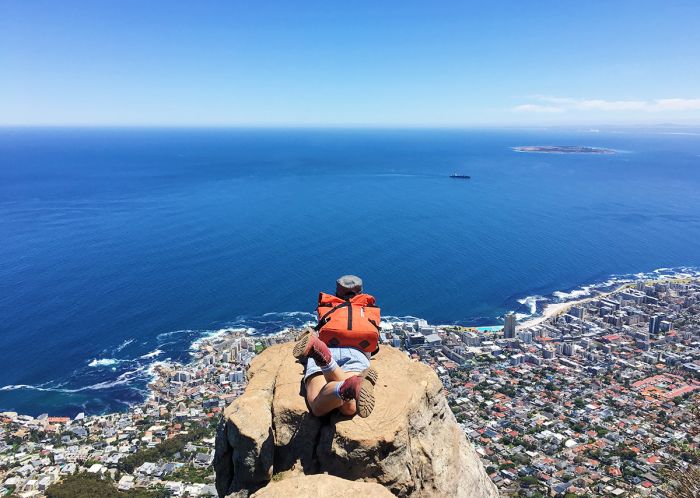
A hiker enjoys the view from Lion's Head peak with Robben Island in Table Bay




